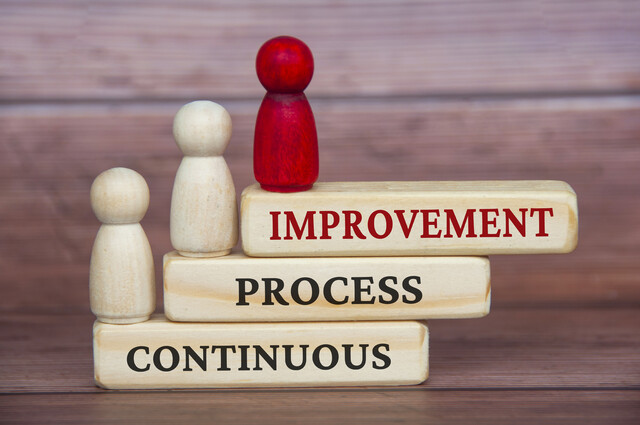Whether the customer is in-house or someone outside, whether a little or a lot of money is involved, the same principle applies. You have a two-headed task: (1) acquire customers, and (2) keep customers.
There are several ways to do this, so let us start with a few methodologies.
Customers' perceptions of what they want are based on reality as they see it. It may be a slanted reality, but their perception is their reality, whether we like it or not. Customers attach their own meaning to their needs, and their needs will fit together for them the same as pieces of a jigsaw puzzle.
To put yourself in your customer's shoes you need to do the following:
Study the customer's particular needs. These are based on a number of factors and usually are directed toward company-oriented gains. Your customer has specific necessities and delivery dates. Find out what they are.
Determine your customer's wants. Customer desires vary by individual but often shape purchase choices, as discussed in the next section.
Identify your customer's fears. All customers have things that cause them concern and they wish to avoid. For example, many worry that the product or service will not be presented in a timely and efficient manner.
Then, observe your customer's pressure points. These are reasons or conditions that could mitigate the price of the product or service. The more customer pressure points operating in a sale, the less important the price is.
Your customer's "wants" are his or her subjective buying criteria. These represent a personal win for the buyer: job security, status, power, etc.
Wants are based on emotion and are individually directed. By focusing on your customer's wants, you are attempting to provide the buying customer with the solution that he or she personally desires.
If you can give buyers what they need, sell them what they want, and help them avoid their greatest fears, you will close more sales.
A number of studies have found that salespeople who sell on the rational and emotional levels are three times more likely to close the sale at a 10 percent to 15 percent higher gross margin.
Standards of Making, Measuring, and Managing
Service standards serve various purposes, but two main ones stand out: First, service standards provide a very powerful way of shaping the image that customers have of your company; and second, they serve as a fantastic management tool to measure how each staff member actually meets the standards set.
Maybe you cannot measure smiles and friendliness, but you can certainly measure the results that come from them.
Be concise. Get right to the point and be clear.
Make standards measurable. Have specific criteria that can be observed and quantified easily.
Base standards on customer needs. Standards must be based on customers' requirements rather than the company's. When you can fully satisfy your customers' needs, you have a big advantage over competitors.
Include standards in job descriptions and performance reviews. This provides a clear understanding of expectations and an incentive for staff to adhere to the standards set forth.
Create the standards along with your staff. Standards should result from a team effort; the very best standards are generally those that are established not just by management but by a group process involving managers and employees.
Enforce the standards. There is no point in establishing standards unless they are enforced, with everyone adhering to them, including the boss!
Reinventing Your Processes to Suit the Customer
Some people see no need to reinvent processes because they tend to evolve as time goes on.
In this view, processes evolve and automatically change. However you see it, change within processes takes place much more rapidly these days. There is no disputing that. Rest assured that we will deal with reinventing processes through automation in a later lesson.
These groups comprise a number of staff members who meet, either face to face or in cyberspace, to solve a specific problem. The group is disbanded after it has successfully completed its task.
The quality group process can take anywhere from a few weeks to months, depending on the range and complexity of the problem.
What to Avoid if You Want to Keep Your CustomersTo retain customers, do not:
assume that the lack of complaints is equal to a satisfied customer base. This is a dangerous thing to do. Customers often simmer away for quite a while before acting or simply go to your competitor for better service.
forget that customer loyalty is built over time through a collection of positive experiences.
ever make the error of treating your customers as if they were expendable.
forget that small things can often matter a great deal to a customer; for example, how you greet your customers on the phone.
keep your customers waiting. If you cannot fulfill a promise when you said you could, contact the customers and explain why. Most will understand and appreciate your courtesy, especially if it is delivered promptly.
renege on your promises
Measuring your customer service is critical for any successful business. But how do you evaluate the effectiveness of your customer service? There are a number of tools, including the often overlooked survey.
We would advise you to use a combination of methods, such as interviews, surveys, focus groups or questionnaires. That way, you are sure to pick up all the appropriate feedback from your customers.
"Oh no, not another survey!" some people might say. Surveys are not high-tech or wildly exciting, but they are exceptionally good for discovering what customers want and expect.
Do not stop at just surveying your customers; survey your staff as well. Staff members are much more likely to be upfront and give you honest feedback if they are allowed to fill out questionnaires anonymously. With regard to customer service, survey customers and staff simultaneously if you can. Why? Because issues that come to light in both groups of responses often correlate.
The type of survey that you use depends on the purpose behind the survey. Here are some options:
Random customer survey: a tried and true, all-around survey that is used to measure overall customer satisfaction and highlight service problems.
Companywide attitude survey: used to evaluate the three main areas that establish the actual service your customer receives. Those three areas are as follows: (1) How satisfied are your staff members with their jobs? (2) Do you have open means of communication with customers and staff? (3) Do employees feel that there is a sense of teamwork companywide?
Lost account survey: Simply, why did we lose this account?
Target account survey: Rather than conducting a random survey of your entire customer base, you may wish to carry out a more focused survey targeting a particular group of clients.
Customer exit survey: Excellent surveys to conduct as customers are leaving your business premises, these can be used to assess their immediate opinion of the service they received.
TIP: Always ensure that you limit your surveys, digital or paper, to no more than two pages.
The questions placed into questionnaires are phrased in one of the following three ways:
Yes or no questions. Otherwise known as "close-ended" questions, this type of questionnaire usually is used to gather more general questions.
Poor to excellent questions. This type of questions usually commences with the words "how" or "what"; for example, "How would you rate the �� service from our company?"
Degree questions. These refer to specific experiences of events, often starting with the words "do," "does," "did" or even "to what degree."
Finding out why a particular customer has stopped doing business with you.
Getting appropriate feedback from customers who also deal with your competitors.
Making an approach to senior managers or executives of customer companies for whom a group setting would be inappropriate.
Focus groups usually give a wealth of feedback in quite a short time, say, an hour to an hour and a half. Remember, though, that you should have an experienced moderator, not just the average employee. The moderation could be an external consultant or someone from within your company, but the person should be experienced and skilled in this field because the success of a focus group largely depends on the moderator's abilities.
The moderator needs to ensure that everyone in the group has his or her chance to speak, keep the group on track, search for the best information possible, and keep detailed notes of the group.
Would you fix your own car? Maybe, but the decision to do it yourself depends on several factors that deserve careful consideration.
The advantages of using in-house employees to conduct a survey are that not only do you save money but people learn more from the experience. There are several disadvantages. First, in-house associates usually are not experts in survey work and therefore are likely to make mistakes, some of which may be costly. They may run into problems that the moderator finds difficult to handle. Worse still, there can be a certain amount of resentment against the moderator by those not chosen to do the job.
A good suggestion is to use an outside consultant once or twice so you can see what is done and how to do it. Then, if you wish, you can try an inside moderator and compare the two.
You should investigate survey types at length before making a choice. The Web is an easy source to do this. Here are some options:
1. Web-based surveys
2. Written questionnaires
3. Telephone surveys
4. Focus groups
5. Face-to-face interviews
6. Customer panels
7. Mystery shopping surveys
It Is How You Say It That Really Counts
Inflections are the wave-like movements of highs and lows in the pitch of your voice. These very same highs and lows can signal your level of interest to the customer.
Yes, some people are born with naturally interesting voices. They do not seem to make any effort to use inflection to sound warm and friendly. Others are not nearly so fortunate; they have to practice the technique.
One way to improve the inflection of your voice is to be aware of how emphasizing certain words changes the feeling of what you are trying to say. If you are one of those people with a monotone speaking voice, you can start to work on that by exaggerating the tone of your words.
Your Computer Is not Always Your Best Friend
There is no doubt that computers have changed the world, including the world of customer service and customer relationships. Computers provide the means to not only store data but also obtain a lot of data for you. Computers also can generate reports for us based on that information.
The Difference Between Data and Information
Once you have a strategy in place and you know what you need to find out about your customers, you should divide your search into two distinct areas: data and information. Both will individually supply you with a great deal of knowledge about your customers and their needs, but to be most effective, they should be used together.
1. Data. Includes anything that can have a number attached to it. For that reason alone, it is invaluable in helping to spot major trends in business. You can compare data from previous years or just last month. What you will find are trends that point to major changes in the company's business and therefore changes in customer service.
2. Information. What is needed to complement customer data is information. This is the knowledge that comes from asking questions, such as why, how, and when. Here's an example: Why do 20 percent of our customers drive past two of our competitors to do business with our company? Here's another: Why are another 15 percent prepared to wait a little longer so they can deal with us?
Ethics and Espionage
What are ethics? The long answer is that ethics are those standards of beliefs and values that guide our conduct, behavior, and subsequent activities. The short answer: simply doing the right thing.
Each of us has gone about our jobs with our own personal sense of values, our own sense of ethical practice. At the same time, though, organizations and leaders for whom we work are also responsible for setting clear ethical standards for the business organization we work for.
Simply speaking, business ethics apply ethical values to the business world. They apply to all aspects of business conduct and service and are relevant to the conduct of individuals working for the company as a whole.
Espionage, on the other hand, refers in this case to industrial, corporate, or business-oriented espionage. It is conducted for commercial purposes, not to ensure national security. There is quite a difference between competitive intelligence gathering, which is examining corporate publications, websites, and the business activities of a corporation, and industrial espionage.
Corporate espionage involves such things as theft of trade secrets, bribery, and blackmail. It is most commonly associated with the computer/technology and automobile sectors.































